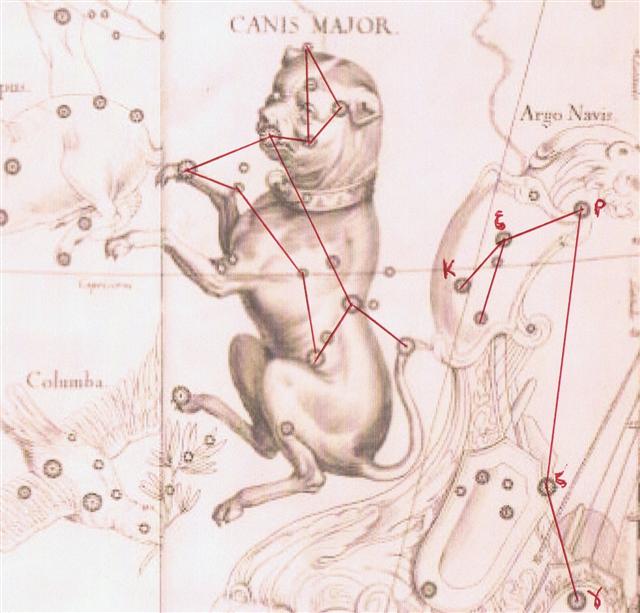|
2. The Argo Navis constellation (divided into Puppis, Vela, and Carina) is far down south, and it stretches long with its last stars in the 11th hour and we therefore are not in a hurry to search for its overall meaning. Allen has not much to say about Naos, ζ Puppis, but what he says is heavy stuff: "ζ, 2.5, at the southeastern extremity of the Egyptian X, is the Suhail Hadar of Al Sufi, and the Naos, or Ship, of Burritt's Atlas; while, with γ and λ, it was one of the Muhlifa´n." One of the names of Canopus was Suhail, or to be more precise Suhail el-wezn (cfr at Camp 8): '... In the inscriptions of Dendera, published by DŘmichen, the goddess Hathor is called 'lady of every joy'. For once, DŘmichen adds: Literally ... 'the lady of every heart circuit'. This is not to say that the Egyptians had discovered the circulation of the blood. But the determinative sign for 'heart' often figures as the plumb bob at the end of a plumb line coming from a well-known astronomical or surveying device, the merkhet. Evidently, 'heart' is something very specific, as it were the 'center of gravity' ... See Aeg.Wb. 2, pp. 55f. for sign of the heart (ib) as expressing generally 'the middle, the center'. And this may lead in quite another direction. The Arabs preserved a name for Canopus - besides calling the star Kalb at-tai-man ('heart of the south') ... Suhail el-wezn, 'Canopus Ponderosus', the heavy-weighing Canopus, a name promptly declared meaningless by the experts, but which could well have belonged to an archaic system in which Canopus was the weight at the end of the plumb line, as befitted its important position as a heavy star at the South Pole of the 'waters below'. Here is a chain of inferences which might or might not be valid, but it is allowable to test it, and no inference at all would come from the 'lady of every joy'. The line seems to state that Hathor (= Hat Hor, 'House of Horus') 'rules' the revolution of a specific celestial body - whether or not Canopus is alluded to - or, if we can trust the translation 'every', the revolution of all celestial bodies. As concerns the identity of the ruling lady, the greater possibility speaks for Sirius, but Venus cannot be excluded; in Mexico, too, Venus is called 'heart of the earth'. The reader is invited to imagine for himself what many thousands of such pseudo-primitive or poetic interpretations must lead to: a disfigured interpretation of Egyptian intellectual life ...' We had better document the facts in a table:
And Procyon and Sirius were the two sisters of Canopus, Al Ahawāt al Suhail. The meaning of wez(e)n is heavy, hadar means the ground, and suhail is the plain: '... the universal Arabic title [of α Carina] was Suhail, written by Western nations Suhel, Suhil, Suhilon, Sohayl, Sohel, Sohil, and Soheil, Sahil, Sihel, and Sihil; all taken according to Buttman, from Al Sahl, the Plain.' I think the implication is that both Canopus and Naos are located in the region down at the 'bottom' of the southern sea. The name Muhlifa´n (in various spellings) points in the same direction. Alsuhail (λ Velorum) in the 10th hour is also a star far down 'at the bottom': 'λ, 2.5, in Vela is Al Sufi's Al Suhail al Wazn, Suhail of the Weight; and, with γ and ζ, one of the Muhlīfaīn ...' 'It [γ Canis Majoris] has the traditional name Muliphein, not to be confused with Muhlifain, which is Gamma Centauri; both names derive from the same Arabic root ... muħlifayn ...' The Centaurus constellation is also far down. Allen mentions that Naos together with γ and λ (both in Vela) 'was one of the Muhlifa´n', a statement we now can understand - there were several constellations by that name far down in the sky. But we will save the discussion about Muhlifa´n = ζ, γ and λ in Argo Navis until the 10th hour where Alsuhail is located. Anyhow, we can guess Naos was one of the stars which was sworn by (cfr at Orion Revisited): ... Royer cut away a portion of Canis Major, and constructed Columba Noachi therewith in 1679. The part thus usurped was called Muliphein, from al-muliphe´n, the two stars sworn by, because they were often mistaken for Sohe´l, or Canopus ... ζ (Naos) is close to 40░ S and the brightest star in Puppis:
|

